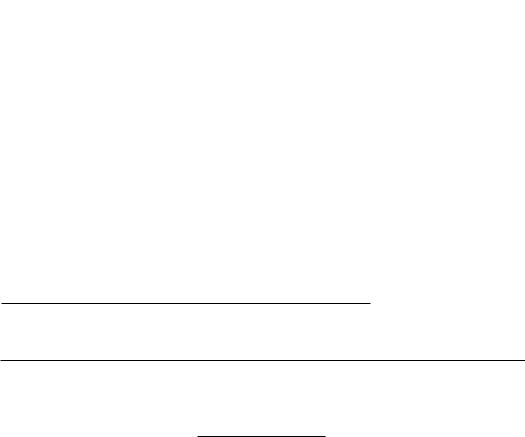
CFA Level 1 (2009) - 5
.pdf
Swdy Session 16
Cross-Reference to CFA Institute Assigned Reading #65 - Yield Measures, Spot Rates, and Forward Rates
Using the TVM caleula t~r functions:
PV = -768; FV = 1,000; PMT = 0; N = 10; CPT I/Y = 2.675% x 2 = 5.35% for the semiannual-pay YTM, and PV =-768; FV =1,000; PMT = 0; N = 5; CPT
-> I/Y = 5.42% for the annual-pay YTM.
The annual-pay YTM of 5.42% means that $768 earning compound interest of 5.42%1 year would grow to $1,000 in five years.
The yield to call is used ro calculate the yield on callable bonds that are selling at a premium ro par. For bonds uading at a premium ro par, the yield to mll may be less than the yield ro maturity. This can he the cast: whc:n the call price is below the currc:Ill market price.
The calculation of the yield to call is the same as the calculation of yield to marurity, except (hat the call price ;s wbstillttcd for the par value in FV and (he Jlttmuer of semiannual periods until the call date is 5II!Jstituted for periods lO maturity, N. When a bond has a period of call protection, we calculate the yield to first call over the period until the bond may first be called, and use the first call price in the calculation as FY. In a similar manner, we can calcula(e the yield to any subsequent call date using (he appropriate call price.
If the bond contains a provision for a call at par at some time in the future, we can calculate the yield to first par call using the number of years until the par call date and par for rile maturity payment. If you have a good understanding of the yield to maturity measure, the YTC is not a difficult calculation; just be very careful about the number of years to the call and the call price for that date. An example will illustrate the calculation of these yield measures.
Example: Computing the YTM, YTC, and yield to first par call
Consider a 20-year, 10% semiannual-pay bond with a full price of 112 that can be called in five years at 102 and called at par in seven years. Calculate the YTM, YTC, and yield to first par call.
Professor's Note: Bond prices are often expressed as a percent ofpar (e.g., 100 = par).
Page 102 |
©2008 Kaplan Schweser |

Study Session 16 Cross-Reference to CFA Institute Assigned Reading #65 - Yield Measures, Spot Rates, and Forward Rates
Answer:
The YTM can be calculated as: N = 40; PV =-112; PMT = 5; FV = 100;
CPT -7 I1Y =4.361 % x 2 =8.72% =YTM.
To compute the yield to first call (YTFC), we substitute the number of semiannual periods until the first call date (10) for N, and the first call price (102) for FV, as follows:
N = 10; PV = -1 12; PMT = 5; FV = 102;
CPT -7 I/Y = 3.71% and 2 x 3.71 = 7.42% = YTI~C
To calculate the yield to first par call (YTFPC), we will substitute the number of semiann ual periods until the first par call date (14) for N and par (100) for FV as follows:
N = 14; PV = -112; PMT = 5; FV = 100; CPT -7I1Y = 3.873% x 2 = 7.746% =
YTFPC
Note that the yield to call, 7.42%, is significantly lower than the yield to maturity, 8.72%. If the bond were trading at a discount to par value, there would be no reason to calculate the yield to call. For a discollnt bond, the YTC will be higher than the YTM since the bond will appreciate more rapidly with the call to at least par and, perhaps, an even greater call price. Bond yields are quoted on a yield ro call basis when the YTC is less than the YTM, which can only be the case for bonds trading at a premium ro the call price.
The yield to worst is the worst yield outcome of any that are possible given the call provisions of the bond. In the above example, the yield (0 first call is less than the YTM and less than the yield to ftrst par call. So the worst possible outcome is a yield of 7.42%; the yield to first call is the yield to worst.
The yield to refunding refers to a specific situation where a bond is currently callable and currellt rates make calling the issue attractive (0 the issuer, but where the bond covenallts contain provisions giving protection from refunding until some future date. The calculation of the yield to refunding is just like that ofYTM or YTC. The difference here is that the yield (0 refunding would use the call price, but the date (and therefore the number of periods used in the calculation) is the date when refunding protection ends. Recall that bonds that are callable, but not currently refundable, can be called using funds from sources other than the iSSllance of a lower coupon bond.
The yield to put (YTP) is used if a bond has a put feature and is selling at a discount. The yield to put will likely be higher than the yield ro maturity. The yield to put calculation is just like the yield to maturity with the number of semiannual periods until the put date as N, and the put price as FV
©2008 Kaplan Schwcser |
Page 103 |

Study Session 16
Cross-Reference to CFA Institute Assigned Reading #65 - Yield Measures, Spot Rates, and Forward Rates
Example: Computing YTM and YTP
Consider a 3-year, 6%, $1,000 semiannual-pay bond. The bond is selling for a full price of $925.40. The first put opportunity is at par in two years. Calculate the YTM and the YTP.
Answer:
Yield to maturity is calculated as:
N ':' 6; FY = 1,000; PMT = 30; PY = -925.40; CPT ---t I/Y = 4.44 X 2 = 8.88% =
YTM
Yield to put is calculated as:
N = 4; FY = 1,000; PMT = 30; PY = -925.40; CPT ---t IN = 5.11 X 2 = 10.22% =YTP
In this example, the yield to put is higher than the YTM and, therefore, would be the appropriate yield to look at for this bond.
The cash flow yield (CFY) is used for mortgage-backed securities and other amortizing asset-backed securities that have monthly cash flows. In many cases, the amount of the principal repayment can be greater than the amount required to amortize the loan over its original life. Cash flow yield (CFY) incorporates an assumed schedule of monthly cash flows based on assumptions as to how prepayments are likely to occur. Once we have projected the monthly cash flows, we can calculate CFY as a monthly internal rate of return based on the market price of the security.
Professor's Note: It is unlikely that you will be required to actually calculate a CFY '~'" on the exam and more likely that you could be required to interpret one. Ifyou
(~ need to calculate a CFY, just use the cash flow keys, put the price ofthe security as C~" a negative value as CF0' enter the monthly cash flows sequentially as CFn's, and
solve for JRR, which will be a monthly rate.
The following formula is used to convert a (monthly) CFY into bond equivalent form:
bond eq uivalent yield = [(1 + monthly CFy)6 - 1] X 2
Here, we have converted the monthly yield into a semiannual yield and then doubled it to make it equivalent to a semiannual-pay YTM or bond equivalent yield.
A limitation of the CFY measure is that actual prepayment rates may differ from those assumed in the calculation of CFY.
Page 104 |
©2008 Kaplan Schweser |

Srudy Session 16 Cross-Reference to CFA Institute Assigned Reading #65 - Yield Measures, Spot Rates, and Forward Rates
The A~sumptionsand Limitations of Traditional Yield Measures
The primary limitation ofthe yield to maturity measure is that it does not tell us the compound rate of return that we will realizc on a fixed-income investmcnt over its life. This is because we do nor know thc rate of interest we will realize on the reinvested coupon payments (the reinvestment rate). IZeinvestment income can be a significant part of the overall return on a bond. As noted earlier, the uncertainry about the return on reinvested cash Rows is referred to as reinvestment risk. lr is higher for bonds with higher coupon rates, other things e(jual, and potentially higher for callable bonds as well.
The realized yield on a bond is the actual compound return that was earned on the initial investment. It is usually computed at the end of the investment horizon. For a bond to have a realized yield equal to its YTM, all cash flows prior to maturity must be reinvested at the YTM, and the bond musr be held until maturity. If thc "average"
reinvestment rate is below the YTM, the realized yield will be below the YTM. For this reason, it is often stated that: The yield to maturit.y assumes ctlsh flows wi/I be reinvested tit the YTM find msumes that the bond wi/I be held until matttrity. This is the point of LOS here.
The other internal rate of return measures, YTC and YTP, suffer from the same shortcomings since they are calculated like YTMs and do not account for reinvestment income. The CFY measure is also an internal rate of return measure and can differ greatly from the realized yield if reinvestment rates are low, since scheduled principal payments and prepayments must be reinvested along with the interest payments.
1,0\ (,').c: F:-.:plain [he imporlance of" rcinvesrm':nt income in W'))Cr;][lllg the yield computed al the time or purcha!\c, cllcr;/atc ["he "Jlll,,")l 01' income
reql1ircd (0 gencrate that yield, and discuss the factors tkn affcct reil1vcHmcnl
,.. :.-J,
! , ,1....
Reinvestment income is important because if the reinvestment rate is less than the YTM, the realized yield on the bond will be less than the YTM. The realized yield will always be between the YTM and the assumed reinvestment rate.
If a bondholder holds a bond until maturity and reinvests all coupon interest payments, the total amount generated by the bond over its life has three components:
1.Bond principal.
2.Coupon in terest.
3.Interest on reinvested coupons.
Once we calculate the total amount needed for a particular level of compound return over a bond's life, we can subtract the principal and coupon payments to determine the amount of reinvestment income necessary to achieve the target yield. An example will illustrate this calculation.
©2008 Kaplan Schweser |
Page 105 |

5rudy Session 16
Cross-Reference to CFA Institute Assigned Reading #65 - Yield Measures, Spot Rates, and Forward Rates
Example: Calculating required reinvestment income for a bond
If you purchase a 6%, 1O-year Treasury bond at par, how much reinvestment income must be generated over its life to provide the investOr with a compound return of 6(Vo on a semiannual basis?
Answer:
Assuming the bond has a par value of $1 00, we first calculate the total value that must be generated ten years (20 semiannual periods) from now as:
100(1.03)20 = $180.61
There are 20 bond coupons of $3 each, total ing $60, and. a payment of $1 00 of principal at maturi ty.
Therefore, the required reinvestment income over the life of the bond is:
180.61 - 100 - 60 = $20.61
Pl'Oftssor's Note: Ifwe had purchased the bond at a premium or di.rcount, we would still use the purchase price (which would not equfd] (0) and the required compound return to calculate the total future dollars required, and then subtract the maturity value and the total coupon payments to get the required reinvestment income.
Factors That Affect Reinvestment Risk
Other things being equal, a coupon bond's reinvestment risk will increase with:
•Higher coupons-because there's more cash flow to reinvest.
•Longer maturities-because more of the total value of the investment is in the coupon cash flows (and interest on coupon cash flows).
In both cases, the amount of reinvested income will playa bigger role in determining the bond's total return and, therefore, inrroducc more reinvestment risk. A non-callable zero-coupon bond has no reinvestment risk over its life because there arc no cash flows to reinvest prior to maturity.
LOS 65.d: Compu(c and intcrpret Ih~ hom! cljuivalent )'ldt! of all annual .. pay bond, and the annual pay yield of a sCini;H1IHLd·pay bfmd.
This LOS requires rhat you be able to turn a semiannual return into an annual rerum, and an annual return into a semiannual return.
Page 106 |
©2008 Kaplan Schweser |

Study Session 16 Cross-Reference to CPA Institute Assigned Reading #65 - Yield Measures, Spot Rates, and Forward Rates
Example: Comparing bonds with different coupon frequencies I
Suppose that a corporation has a semiannual coupon bond trading in the United States with a YTM of6.25%, and an annual coupon bond trading in Europe with a YTM =
6.30%. Which bond has the greater yield?
Answer:
To determine the answer, we can convert the yield on the aunt/ai-pay bond to a (semiannual-pay) bond equivalent yield. That is:
1
BEY of an annual-pay bond = [(1 + annual YTM)2 - 1] x 2
Thus, the BEY of the 6.30o,f) annual-pay bond is:
[(1 +0.0630)°·5 -1] x 2 = [1.031-1] X 2 = 0.031 X 2 = 0.062 = 6.2%
The 6.25% semiannual-pay bond provides the better (bond equivalent) yield.
Alternatively, we could convert the YTM of the semiannual-pay bond (which is a bond equivalent yield) to an equivalent annual-pay basis. The equivalent annual yield
(EAY-JometimeJ known aJ the ('ffietive a IlIlUa Iyield) to the 6.25% semiannual-pay YTM is:
equivalent annual yield = (1 + 0.0~25r-1 = 0.0635 - f 6.35%
The EAY of the semiannual-pay bond is 6.35%, which is greater than the 6.3% for the annual-pay bond. Therefore, the semiannual-pay bond has a greater yield as long as we put the yields on an equivalent basis, calculating both as annual yields or calculating both as bond equivalent yields (semiannual yields X 2).
LOS 65.<::: Describe tile methodology for COjllPlilill~), (he thcorcticalln:aHlry spot rate curve and COlnpule rhe va!ue OJ';l bUild using spot rates.
The par yield curve gives the YTMs of bonds currently trading near their par values (YTM ;:::; coupon ratc) for various maturities. Here, we need to usc these yields to get the theoretical Treasury spot rate curve by a process called bootstrapping.
The method of bootstrapping can be a little confusing, so let's first get the main idea and then go through a more realistic and detailed example. The general idea is that we will solve for spot rates by knowing the prices of coupon bonds. We always know one spot rate to begin with, and then calculate the spot rate for the next longer period. When we
©2008 Kaplan Schweser |
Page I (f" |

SrudyScssion 16
Cross-Reference to Cf<A Institute Assigned Reading #65 - Yield Measures, Spot Rates, and Forward Rates
know two spot rates, we pm get the third based on the marker price of a bond wirh three cash Rows by using the spot rates to get the present values of the first two cash flows.
As an example of this method, consider that we know the prices and yields of three annual-pay bonds as shown in Figure 2. All three bonds arc trading at par or $1,000.
Figure 2: Prices and Yield for Three Annual-Pay Bonds
Maturity |
COl/POll |
Yield |
Price |
|
|
|
|
|
|
1 year |
3% |
3% |
$1,000 |
|
2 years |
4% |
4% |
$1,000 |
|
3 years |
5% |
5% |
$1,000 |
|
|
|
|
|
|
Since the I-year bond makes only one payment (it's an annual-pay bond) of $1 ,030 at maruri ty, the I-year spot rate is 3%, the yield on this single payment. The 2-year bond makes two payments, a $40 coupon in one year and a $1,040 payment at maturity in two years. Since the SpOt rate to discount the 2-year bond's first cash Row is 3%, and since we know that the sum of the present values of the bond's cash flows must equal its (no-arbitrage) price of $1 ,000, we can write:
~ |
+ |
1,040 |
= $1000 |
1.03 |
(I + 2-year spot rate) 2 |
' |
Based on this we can solve for the 2-year spot rate as follows:
1. |
1,040 |
|
40 |
=1,000 - 38.83 |
=961.17 |
----- 2 |
=1,000 - - |
||||
|
(I + 2-year spot) |
|
1.03 |
|
|
2. |
1,040 |
|
=1.082 |
|
|
-- =(I + 2-year spot)2 |
|
||||
|
961.17 |
|
|
|
|
3.2-year spot =(1.082)2 -1 =0.04019 = 4.019%
Now that we have both the I-year and 2-year spot rates, we can use the cash flows and price of the 3-year bond to write:
~ + |
50 + |
1,050 |
= 1,000 |
1.03 |
(1.04019)2 |
(I + 3-year spOt)3 |
|
Page 108 |
©2008 Kaplan Schweser |

Study Session 16 Cross-Reference to CfA Institute Assigned Reading #65 - Yield Measures, Spot Rates, and Forward Rates
And solve for the 3-year spot ~ate:
1,000 --- --50 --- |
----50::: . : |
------1,050 |
1.03(1.04019)2 (I +3-year spot)3
1,000-- 4H. 54 - |
1,050 |
|
46.21 = |
||
|
|
(1 +3-yea r spot)3 |
905.25 = |
1,050 |
|
. |
(1 + 3-year spot)3 |
|
|
1/ |
|
l,050 |
)/3 |
|
l |
- 1 |
= 3-year spot = 0.05069 = 5.069% |
--- |
||
905.25 |
|
|
So we can Slate that: |
||
)0 + |
50 |
+ 1,050 = $1,000 |
1.03(1.04019)2 (1.05069)3
\\'e have just solved for the 2-year and 3-year spot rates by the method of bootstrapping.
In practice, Treasury bonds pay semiannually and their YTMs are semiannual-pay YTMs. The next example illustrates the method of bootstrapping when coupons arc paid semiannually.
Consider the yields on coupon Treasury bonds trading at par given in Figure 3. YTM for the bonds is expressed as a bond equivalent yield (semiannual-pay YTM).
Figure 3: Par Yields for Three Semiannual-Pay Bonds
Maturity |
Y7M |
Coupon |
Price |
|
|
|
|
|
|
6 months |
5% |
5% |
100 |
|
1 year |
6% |
6% |
100 |
|
18 months |
7% |
7% |
100 |
|
|
|
|
|
|
The bond with six months left to maturity has a semiannual discount rate of
0.05/2 = 0.025 = 2.5% or 5% on an annual BEY basis. Since this bond will only make one payment of 102.5 in six months, the YTM is the spot rate for cash flows to be received six months from now.
The bootstrapping process proceeds from this point using the fact that the 6-month annualized spot rate is 5% together with the price/YTM information on the I-year bond. We will use the formula for valuing a bond using sPOt rates that we covered earl ier.
©2008 Kaplan Schweser |
Page 109 |

Study Session 16
Cross-Reference to CFA Institute Assigned Reading #65 - Yield Measures, Spot Rates, and Forward Rates
Noting that thc I-year bond will make two paymcnts, one in six monrhs of 3.0 and one in one year of 103.0, and that the appropriate spor rate to discount the coupon payment (which comes six months hom now), we can write:
3 |
103 |
|
|
I S' |
is rhc annualized I-ycar spar rarc, |
|||
-- + ------- l - = 100, w 1ere , I 0 |
||||||||
1025 ( |
S)- |
|
. |
|
|
|||
|
I +'1.02 |
|
|
|
|
|
|
|
|
S n/ |
|
103) |
100- 2.927 = 97.073 |
||||
and solve for' |
";12 as: ------,.-, =c |
100---"- = |
||||||
|
|
|
(I |
+ Sl.~/;r |
1.02 5 |
|
||
103 |
( |
S 11/)2 |
' so |
|
|
|
|
|
|
|
|
|
|
||||
97.073 =co |
1+ |
1.;12 |
|
|
|
|
|
|
== 0.030076 and S, ,0 =. 2 x 0.030076 = 0.0(,0 152 c: 6.0152%
Now that we have the 6-monrh and I-year spot ratcs, we can use this information and the price of the IS-month bond to set the bond price equal to the value of the bond's cash flows as:
3.5 |
3.5 |
, |
103.5 |
|
I )0 |
-- + |
|
T |
|
=(, |
|
1.025 (1.030076)2 |
(I +S1.Y2f |
|
|
||
where 51.5 is the annualized |
1.5-year spot rate, :1l1d solve for S1.j{ |
||||
103.5 |
|
3.5 |
3.5 |
4 |
|
---- 3 |
=100 ---- |
|
2 =100-3. 15-3.30=93.285 |
||
(I +S1./{] |
|
1.025 |
(1.030076) |
||
To summarize the method of bootstrapping spot rates from the par yield curve:
1.Begin with the 6-month spot rate.
2. Set the val ue of the I-year bond cq ual to the present value of the cash flows wi th the I-year spot rate divided by two as the only unknown.
3.Solve for the I-year spot rate.
4.Use the 6-month and I-year spot rates and equate the present value of the cash flows of the 1.5 year bond equal to its price, with the 1.5 year spot rate as the only unknown.
5.Solve for the 1.5-year spot rate.
Page j 10 |
©2008 Kaplan Schweser |

Study Session 16 Cross-Reference to CFA Institute Assigned Reading #65 - Yield Measures, Spot Rates, and Forward Rates
(f;f.•.:'-:.~.·~.'_":f.il |
Proji'SJor's Note: You are rl'sponsiUe for "d{'scribing" this methodology, not for |
. / |
"computi/lg" thfore,iU// spot mtl'S. |
Example: Valuing a bond using spot rates
Given the following spot rates (in BEY form):
0.5years = 4%
1.0years = 5%
1.5years = 6%
Calculate the value of a 1.5 year, 8% Treasury bond.
Answer:
Simply layout the cash flows and discount by the spOt rates, which are one-half the quoted rates since they are quoted in BEY form.
or, with the TVM function:
N = 1; PMT = 0; ItY = 2; FV = 4; CPT - 7 PV = -3.92
N = 2; PMT = 0; I1Y = 2.5; FV = 4; CPT - 7 PV = -3.81
N = 3; PMT = 0; I1Y = 3; FV = 104; CPT - 7 PV = -95.17
Add these values together to get 102.9.
l.OS |
(15.f: Diffcrcllri;1